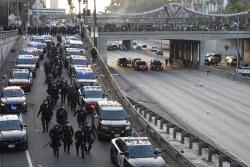
At the very outset of oral argument in Trump v. CASA, the “birthright citizenship” case, Justice Sonia Sotomayor proposed a hypothetical aimed at scaring conservatives. What if the president were to proclaim a new interpretation of the Second Amendment, and add that the military would confiscate all firearms held by private citizens?
That threat fell flat, largely because by then, only a few minutes into the argument, the scary threat was already before the justices in the person of Solicitor General John Sauer. Donald Trump’s administration had come to the Court to ask for help finding new ways for the president to ignore orders from the federal courts.
Thursday’s argument had two aspects, which appeared and disappeared like the Katzenjammer Kids playing peekaboo throughout the nearly three hours of oral argument. The Court had formally assembled to hear the first: When is it okay for one federal district judge to block a government policy nationwide?
The second was: Has every Congress, every Court, and every administration for the past century and a half read the Fourteenth Amendment’s Citizenship Clause wrong, leaving Donald Trump, on his sole authority, to upend the rule that all babies born in the U.S., except the children of diplomatic families, are citizens at birth?
Though Sauer began his argument by boldly proclaiming the administration’s novel interpretation of the Amendment (it applied, he said, only to the children of free slaves in 1868 and has no effect on the children of immigrants today), he quickly moved to the administration’s real aim in bringing this “emergency docket” application before the Court.
In Sauer’s view, the case was about a broader issue than the permissibility of “universal injunctions” (federal district court orders that block new executive policies nationwide). Article III of the Constitution, which created the federal judiciary and gives it its powers, he argued, does not permit any federal court, at any level, to issue such injunctions.
This raises the question: What if the government loses in the district court—and then loses again in the Court of Appeals? What if it loses in the Supreme Court? What court can order it to stop engaging in behavior that Article III courts have found to violate the Constitution?
Without quite saying so, Sauer let it be known that the answer is: None.
If plaintiffs won in the Supreme Court, he graciously conceded, they could take the judgment to the bank—for themselves, that is. But Sotomayor asked him, once the Court decided the constitutional issue, would its order bind the government to stop the unconstitutional action against anyone?
Well . . . said Sauer . . . Not so much.
The result of such a case, Sauer said, would not be a Supreme Court order binding everyone else, but instead a Supreme Court precedent. And of course, plaintiffs still being injured by a government policy (for example, by being rendered stateless by an executive order) could cite that precedent in their cases. “If there was a decision that violated the precedent of the Court, then the affected plaintiffs could get a separate judgment,” he said.
Responded Sotomayor, “You’re talking about the hundreds and thousands of people who weren’t part of the judgment of the court. They would all have to file individual actions?”
Maybe not, said Sauer—if the case could satisfy “the rigorous criteria of Rule 23,” to be certified as a class action.
But if not, said Sotomayor, “you are claiming that not just the Supreme Court—that both the Supreme Court—and no lower court can stop an executive from universally, from violating those holdings by this Court.”
Later in the argument, Justice Amy Coney Barrett asked Sauer what would happen if the Court of Appeals affirmed an injunction from a district court in, hypothetically, the Second Circuit—would the administration follow the order then? “Did I understand you correctly to tell Justice Kagan that the government might want to reserve its right to maybe not follow a Second Circuit precedent,” even in the Second Circuit itself?
“Our general practice is to respect those precedents,” Sauer responded. “We generally respect circuit precedent, but not necessarily in every case.”
To clarify, Barrett said, “I’m talking about this week, the Second Circuit holds that the Executive Order is unconstitutional—what do you do the next day or the next week?”
“Generally, we follow it.” Except, he did not add, when we don’t wanna.
Justice Ketanji Brown Jackson returned to this question: “Your argument seems to turn our justice system, in my view at least, into a ‘catch me if you can’ kind of regime…where everybody has to have a lawyer and file a lawsuit in order for the government to stop violating people’s rights.”
Jackson is right. Unless the case were certified as a class action, those playing the catch-me game would have to litigate their cases from scratch, beginning in a federal district court somewhere, and rising to a court of appeals, and perhaps from there to the Supreme Court, hoping that the precedent would still be good (not undermined by, let’s say, newly appointed justices) by the time their cases got there. And in the meantime, the government could go on its merry way, denying citizenship to each specific baby until that child brought a specific lawsuit on the identical issue.
Because, unlike an order, a precedent is binding only in the sense that the lower courts must follow it unless the Supreme Court changes its mind. And the Trump administration does not regard itself as bound by a previous Supreme Court decision. Remember that, as Sotomayor pointed out, the birthright citizenship rule has, over 125 years, been affirmed by the Court no fewer than four times.
But those precedents haven’t stopped Trump from declaring all those cases were wrong—and that he was overruling them by writ of Sharpie.
A president assuming the authority to overrule decades-old Supreme Court cases might, one assumes, feel entitled to overrule a Supreme Court decision reached last year or yesterday, and telling American babies, one by one, I don’t want you as a citizen; you got a problem with that? Sue me.
This is a bold argument coming from an administration that has repeatedly defied federal court orders even when they are not “nationwide,” but simply orders about a specific person or persons; that has proclaimed courts have no authority to interfere with executive orders; and that has threatened impeachment (or worse) against judges it dislikes.
Admittedly, the issue of “universal” (nationwide) injunctions has been simmering since before the first Trump administration. When is it okay for one federal trial court judge to block a massive government program across the country—such as Barack Obama’s Deferred Action for Childhood Arrivals (DACA) immigration rule (blocked by a Texas trial judge), Donald Trump 45’s “Travel ban” (blocked by a Washington trial judge), Joe Biden’s student loan debt relief program (blocked by a Texas trial judge), or Donald Trump 47’s orders to school districts to stop using or teaching diversity, equity, and inclusion (DEI) policies (blocked nationwide by four different trial judges).
There are good reasons to question whether trial courts should have such broad powers, and if so, whether only in a limited set of cases. A resolution of that question is arguably on the Court’s “must-do-soon” list. But for reasons of its own, the Trump administration has chosen to try to resolve this issue not as part of a case that presents it in a principled way—about differing interpretations of ambiguous federal statutes, constitutional issues that haven’t been resolved in previous cases, or splits in opinion among the federal circuits—times when it might make sense to limit a lower court’s order just to those involved. But in this case, Trump has set aside a federal statute, four Supreme Court cases, and over a century of executive interpretation to impose an invented rule that will cause chaos if put into effect.
This case seems like a poster child for, not against, a nationwide injunction. If a president can simply wave away that much adverse authority—and then only grudgingly apply his losses in court—then the role of the federal courts will be, from now on, quite different from the one they have played for the past 100 years. American-style judicial review would become something like the Mexican writ of amparo, by which parties can get a judgment blocking an unconstitutional law only as to their individual cases; others in the same situation must go to court to get their own amparo. In the atomized world envisioned by the administration, judicial review might be called the Writ of Sisyphus. No matter how often a court pushes the rock up the hill, it will face the same task over and over if the government so chooses.
Conservative justices Brett Kavanaugh and Neil Gorsuch, who seem uneasy with nationwide injunctions, appeared to be looking for a way to limit their scope or number.
But the act of judicial self-cancellation that the administration requests of the justices seems like a heavy lift. Go ahead, Sauer seemed to be saying, make yourselves irrelevant.
The post In Birthright Citizenship Case, Trump DOJ Asks Supreme Court Justices to Make Themselves Irrelevant appeared first on Washington Monthly.


 3 weeks ago
13
3 weeks ago
13 










 Bengali (Bangladesh) ·
Bengali (Bangladesh) ·  English (United States) ·
English (United States) ·